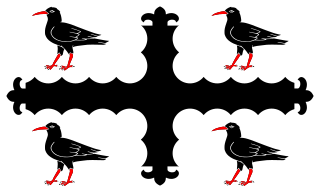
Flintshire is a county in the north-east of Wales. It borders the English county of Cheshire to the east, Denbighshire to the west and Wrexham County Borough to the south. It is named after the historic county of the same name which has notably different borders. Flintshire is considered part of the Welsh Marches and formed part of the historic Earldom of Chester and Flint. The county is governed by Flintshire County Council which has its main offices in County Hall, Mold.

Thomas Pennant was a Welsh naturalist, traveller, writer and antiquarian. He was born and lived his whole life at his family estate, Downing Hall near Whitford, Flintshire, in Wales.

Flintshire, also known as the County of Flint, is one of Wales' thirteen historic counties, and a former administrative county. It mostly lies on the north-east coast of Wales.

The River Dee is a river in the United Kingdom. It flows through parts of both Wales and England, forming part of the border between the two countries.

Abermorddu is a village in the county of Flintshire, Wales, in the community of Hope. Approximately 5 miles north of Wrexham along the A541 road, it is contiguous with the main village of Caergwrle and closely related to the village of Hope. In the 19th century there was a turnpike road known as Abermorddu Branch running from the tollhouse at King's Ferry to Abermorddu.

Mynydd Isa[ˌmənɨ̞ð ˈɪsa] is a village in Flintshire, in north-east Wales. It lies between the county town of Mold, and Buckley in the community of Argoed which had a population of 5837 according to the 2011 census. Mynydd Isa was originally a small hamlet on the north side of the Mold to Buckley road just downhill from the now demolished Calvinist chapel. It did not appear on Ordnance Survey maps until 1912.

The River Alyn is a tributary of the River Dee. The River Alyn rises at the southern end of the Clwydian hills and the Alyn Valley forms part of the Clwydian Range and Dee Valley Area of Outstanding Natural Beauty. The main town on the river Alyn is Mold, the county town of Flintshire. It lends its name to the constituencies of Alyn and Deeside in the UK Parliament and the Senedd.

Hope is a small village and community in Flintshire, north-east Wales. The village is located approximately 3 miles / 4.5 km from the Wales-England border, on the course of the River Alyn, and less than 5 miles from Wrexham.

Ogof Nadolig is a cave in the Alyn Gorge near Cilcain, Flintshire, Wales. It is mostly crawling, 300 metres (980 ft) long, and ends with a shaft up to the surface and a locked manhole cover.

The River Ely is in South Wales flowing generally southeast, from Tonyrefail to Cardiff.

The River Cegidog is a river in north-east Wales. It flows mainly through Flintshire but towards the end of its course it forms the border between Flintshire and Wrexham County Borough.

Nercwys is a rural village and community in Flintshire, Wales, which is surrounded by open countryside. The community population taken at the 2011 census was 585. The older, Anglicised spelling of Nerquis can sometimes be found. It has a small school and a local bus service to Mold which is around 3 miles away.

North Wales was a European Parliament constituency which roughly covered the geographic region of North Wales, from 1979 until 1999. It was held by the Conservative Party from 1979 until 1989, during which time it was their only seat in Wales.

Rhydymwyn is a village in Flintshire, Wales, located in the upper Alyn valley. Once a district of Mold, it was recognised as a separate parish from 1865. It is now part of the community of Cilcain.

The Afon Dwyfor is a river in Gwynedd, north-west Wales, in total the river is 12+1⁄2 miles (20.1 km) in length. It rises in Cwm Dwyfor at the head of Cwm Pennant, gathers to itself numerous streams which drain the surrounding mountains from Mynydd Graig Goch in the west to Moel Hebog in the east, then flows southwest towards Dolbenmaen and out of the Snowdonia National Park.

The Clwydian Range and Dee Valley is a designated Area of Outstanding Natural Beauty (AONB) and proposed national park, located in north-east Wales, covering the Clwydian Range, and the valley of the River Dee. Designated in 1985 as the Clwydian Range AONB, and expanded to its current form in 2011, the Area of Outstanding Natural Beauty includes: medieval field systems, open heather moorland, prehistoric hillforts, limestone crags, broad leaved woodland, wooded valleys, and farmland. In 2018, an estimated 1.1 million people visited six key sites across the AONB, generating approximately £24.1 million to the Welsh economy, according to Natural Resources Wales. The AONB falls within the jurisdiction of the local authorities of Denbighshire, Flintshire, and Wrexham County Borough, with the majority, 80% of the AONB in Denbighshire, and the remaining 20% split evenly between the other two authorities. The AONB is the largest of only five AONBs in Wales, and one of the 46 in the United Kingdom. Additionally, it is one of only 8 protected areas of Wales. Long-distance footpaths; Offa's Dyke Path, and the Clwydian Way pass through the AONB. The area of the Clwydian Range and Dee Valley AONB is 390 km2 (150 sq mi), and has been proposed by the Welsh Government to become Wales' fourth national park.
Mynydd Isa Spartans Football Club is a Welsh football team based in Mynydd Isa, near Mold, Flintshire, Wales. The team currently play in the North East Wales Football League Premier Division, which is at the fourth tier of the Welsh football league system.

















